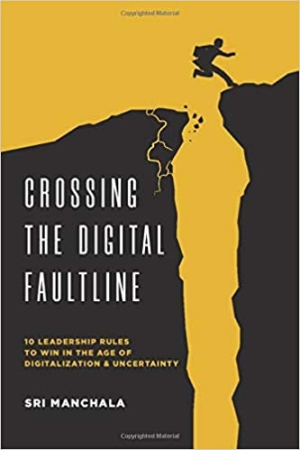Crossing the Digital Faultline
10 Leadership Rules to Win in the Age of Digitalization and Uncertainty
Crossing the Digital Faultline is a helpful business book that suggests ways to find and retain customers in a changing world.
Sri Manchala’s inspired business book Crossing the Digital Faultline addresses the contemporary business landscape.
Beginning with a gripping account of Manchala’s escape from Tokyo following the 2011 Tohoku earthquake that caused a nuclear meltdown and killed thousands, the book argues that small but deep structural shifts can have large effects. This feeds into the book’s concept of a “digital faultline” that impacts how businesses operate. With advice on understanding structural changes and adapting leadership accordingly, the text speaks to companies that are looking toward the future.
The book’s four parts first track digital changes, then address leadership implications; they present ten rules for change, all leading into a 120-day playbook. This logical structure moves from urgent opening chapters into clear steps; most of the book is concentrated on the ten rules, which include smart suggestions such as to “replace assumptions with data analysis” and “disrupt yourself before the tech industry does it for you.” This practical framework will be useful for business leaders contemplating their next moves.
“At any moment,” Manchala says, “the ground may shift underneath us.” But still, he says, many businesses are not working to meet their customers’ expectations—they do not have reliable websites, maybe, or are not easy to contact. Such arguments draw upon an extensive survey, the Trasers Global Transformation Survey, that generated 1.5 million data points across twenty industries—results that Manchala draws on to suggest that big-name, established organizations might not make it if they don’t shift their focus to data-driven decision making.
Supporting examples and personal anecdotes from Manchala’s time in the military help to stress the importance of planning and leadership; both elements make the text more engaging. Big businesses like Amazon are also addressed to show what is possible when leadership is forward thinking; these are a source of inspiration. Source materials are defined in the book’s appendixes, adding additional weight to its observations.
With a pep talk quality that emphasizes values such as that it’s okay to say “I don’t know,” the text holds interest. Its big-picture theories and ideas tell an intriguing story about the future of business, while its charts and graphs highlight ideas well, as with a pie chart that shows how the iCloud factors in to the product and service development cycle. It stays aware of day-to-day challenges, even addressing how COVID-19 is transforming how people work and appending its ten rules to focus on challenges specific to the pandemic.
Arguing that methodical innovators will be the ones to succeed despite difficult times, Crossing the Digital Faultline suggests ways to find and retain customers in a changing world.
Reviewed by
Jeremiah Rood
Disclosure: This article is not an endorsement, but a review. The publisher of this book provided free copies of the book and paid a small fee to have their book reviewed by a professional reviewer. Foreword Reviews and Clarion Reviews make no guarantee that the publisher will receive a positive review. Foreword Magazine, Inc. is disclosing this in accordance with the Federal Trade Commission’s 16 CFR, Part 255.

